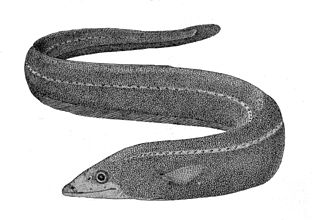Ophidiiformes is an order of ray-finned fish that includes the cusk-eels, pearlfishes, viviparous brotulas, and others. Members of this order have small heads and long slender bodies. They have either smooth scales or no scales, a long dorsal fin and an anal fin that typically runs into the caudal fin. They mostly come from the tropics and subtropics, and live in both freshwater and marine habitats, including abyssal depths. They have adopted a range of feeding methods and lifestyles, including parasitism. The majority are egg-laying, but some are viviparous.

The muddy arrowtooth eel, Ilyophis brunneus, is a cutthroat eel in the family Synaphobranchidae. It is found around the world at depths below 1,000 m. Its length is up to 160 cm.
The snubnosed eel, Simenchelys parasitica, also known as the pug-nosed eel, slime eel, or snub-nose parasitic eel, is a species of deep-sea eel and the only member of its genus. Some authors classify it as the sole member of the subfamily Simenchelyinae of the family Synaphobranchidae, or cutthroat eels, while others place it in its own monotypic family, the Simenchelyidae. It is found in the Atlantic and Pacific Oceans, typically at a depth of 500–1,800 m (1,600–5,900 ft) near the bottom. Although typically a scavenger, it is better known for using its powerful jaws and teeth to burrow into larger fishes as a parasite.

Synaphobranchus is a genus of eels in the cutthroat eel family, Synaphobranchidae. It currently contains the following species:

Ilyophis is a genus of eels in the cutthroat eel family Synaphobranchidae.

Histiobranchus is a genus of eels in the family Synaphobranchidae. It currently contains the following species:
Cut-throat, cutthroat or cut throat or their plurals may refer to:

An eel is a ray-finned fish belonging to the order Anguilliformes, which consists of eight suborders, 19 families, 111 genera, and about 800 species. Eels undergo considerable development from the early larval stage to the eventual adult stage, and most are predators.
Atractodenchelys is a genus of eels in the cutthroat eel family, Synaphobranchidae.

Dysomma is a genus of eels in the cutthroat eel family Synaphobranchidae.

Dysommina is a genus of eels in the cutthroat eel family Synaphobranchidae. It currently contains the following species:
Meadia is a genus of eels in the cutthroat eel family Synaphobranchidae. It currently contains the following species:

Dysomma anguillare, the shortbelly eel, stout moray, mustard eel or arrowtooth eel, is an eel in the family Synaphobranchidae. It was described by Keppel Harcourt Barnard in 1923. It is a marine, tropical eel which is known from the western Atlantic Ocean and Indo-Western Pacific, including the United States, Venezuela, South Africa, Zanzibar, and Japan. It lives at a depth range of 30 to 270 metres, and inhabits muddy sediments in coastal waters and large rivermouths. Males can reach a maximum total length of 52 centimetres (20 in).

Dysommina rugosa is an eel in the family Synaphobranchidae. It was described by Isaac Ginsburg in 1951. It is a marine, deep water-dwelling eel which is known from the western Atlantic and eastern central Pacific Ocean. It dwells at a depth range of 260–775 metres, and is found off the continental slope. Males can reach a maximum total length of 37 centimetres.
Ilyophis blachei is an eel in the family Synaphobranchidae. It was described by Luiz Vieria Caldas Saldanha and Nigel Merrett in 1982. It is a marine, deep water-dwelling eel which is known from the northeastern and southeastern Atlantic and southern Indian Ocean. It dwells at a depth range 580 to 2,070 metres, and inhabits the continental shelf. Males can reach a maximum total length of 79.2 centimetres (31.2 in).
Ilyophis robinsae is an eel in the family Synaphobranchidae. It was described by Yuri Nikolaevich Shcherbachev and Kenneth J. Sulak in 1997. It is a marine, deep water-dwelling eel which is known from the Philippines, in the Indo-West Pacific. It is known to dwell at depths of 4,800 metres (15,700 ft) to 5,180 metres (16,990 ft). Males can reach a maximum total length of 34.8 centimetres (13.7 in).
The Abyssal cutthroat eel is an eel in the family Synaphobranchidae. It was described by Toshiji Kamohara in 1938. It is a marine, deep water-dwelling eel which is known from the Indo-Pacific, including Brazil, the Hancock Seamount, the Hawaiian and Society islands, Japan, Mauritius, and Réunion. It is found off the continental slope, and dwells at a depth range of 100–329 metres. Males can reach a maximum total length of 73 centimetres.

The Shortdorsal cutthroat eel is an eel in the family Synaphobranchidae. It was described by Albert Günther in 1887. It is a marine, deep water-dwelling eel which is known from the Indo-Pacific and western central Atlantic Ocean, including Zanzibar, Maldives, Australia, Japan, Suriname, and the Gulf of Mexico. It dwells at a depth range of 900 to 3,000 metres, most often between 1,000 to 2,500 metres, and leads a benthic lifestyle, inhabiting the continental slope. Males can reach a maximum total length of 111 centimetres (44 in).
The Kaup's arrowtooth eel is an eel in the family Synaphobranchidae. It was described by James Yate Johnson in 1862. It is a marine, deep water-dwelling eel which is known from the Indo-Western Pacific and eastern and western Atlantic Ocean, including the Faroe Islands, Iceland, Cape Verde, the Western Sahara, Nigeria, Namibia, South Africa, Greenland, France, Saint Pierre and Miquelon, the United Kingdom, Ireland, the Philippines, Portugal, Spain, the Bahamas, Brazil, Canada, Cuba, Japan, Australia, Mauritania, Morocco, and Hawaii. It dwells at a depth range of 120 to 4,800 metres, most often between 400 to 2,200 metres, and inhabits the upper abyssal zone on the continental slope. It is intolerant of the temperatures of higher waters. Males can reach a maximum total length of 100 centimetres (39 in).








